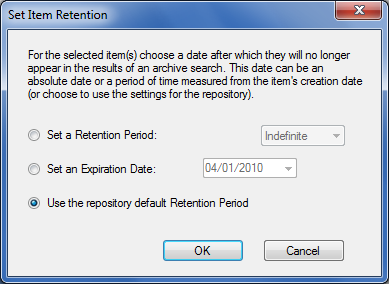This article refers to the Barracuda ArchiveOne for Files version 7.2.0 and higher.
A repository represents a static snapshot of your data at the time of archival. This data can remain in your repository indefinitely. However, if your organization needs to retain data for a fixed period of time, you can set the retention period on a repository, after which data is safely and legally removed. Note that you can also set individual item retention as described below in the section Overriding Repository Retention Period.
Repository Retention
When a repository is created, you specify where the data is located, either locally or via a network resource. A repository also has an additional property relating to retention of data stored within it. To view the retention property, open the Properties dialog for the desired property, as shown in Figure 1.
Figure 1. Repository Properties dialog box.

The Retention Period property indicates how long an item is to remain in the repository before it expires. By default, a repository is set to an Indefinite retention period. This means that items within the repository never expire. However, you can specify that items are to expire after a specified period of time. You can specify days, months, or years when setting the retention period.
Retention Period Calculation
The retention period for each item is calculated from the time the item is archived. For example, if you set the retention period to three months, then any item that was archived more than three months ago automatically expires. You can change a repository's retention period at any time; any change you make takes effect immediately on all items within that repository.
Expired Items
Once an item has expired, for example, due to the repository retention period, it is automatically moved to the Recycle bin. Once moved, the item is no longer available for retrieval and no longer displays in search results unless you specify that you want to search for expired items.
If items have been moved to the Recycle bin, you can select to change the retention period on a repository, making those items available again. Otherwise, you can purge the Recycle bin from the Management Console, permanently removing these items from the repository.
Overriding Repository Retention Period
By default, all items within a repository automatically inherit the retention period of that repository. However, in some circumstances you may wish to change the retention period of individual items within a repository. You can do this through the Search option within the Management Console. Once you have a set of search results, you can select one or more items and set an individual retention period. To do so, right-click the selected items, and click Set Retention. The Set Item Retention dialog box displays, as shown in Figure 3.
Figure 3. Set Item Retention.

Delete Items Directly
In addition to using retention periods to remove items from your repository, you can select to delete them directly from the search results. Once you have a set of search results, you can select one or more items and directly delete them. To do so, right-click the selected items, and click Delete. The items are moved to the Recycle bin. If you decide to change your mind, you can go to the Recycle bin and restore the files back to the original repository.
